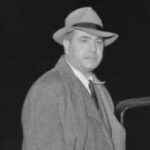
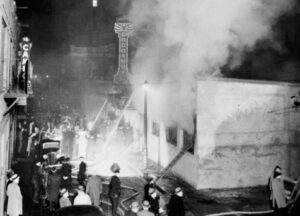 One of the saddest realities is that safety standards are often the result of a tragedy. That is exactly what happened during what is still the deadliest nightclub fire in the world, and the second-deadliest single-building fire…after the Iroquois Theatre fire. On November 28, 1942, Cocoanut Grove was well known as one of Boston’s most popular nightspots. The club attracted many celebrity guests and Boston’s most elite citizens. The fire was a tragedy that later became the catalyst for change in fire prevention, and how to survive a fire. Unfortunately, 492 people have to pay for these lessons with their lives.
One of the saddest realities is that safety standards are often the result of a tragedy. That is exactly what happened during what is still the deadliest nightclub fire in the world, and the second-deadliest single-building fire…after the Iroquois Theatre fire. On November 28, 1942, Cocoanut Grove was well known as one of Boston’s most popular nightspots. The club attracted many celebrity guests and Boston’s most elite citizens. The fire was a tragedy that later became the catalyst for change in fire prevention, and how to survive a fire. Unfortunately, 492 people have to pay for these lessons with their lives.
The Cocoanut Grove was owned by Barnet “Barney” Welansky, who was closely connected to the Mafia and to Mayor Maurice J Tobin. As often happens, anyone connected to the Mafia and/or a politician, also believes they are above the law. They do things the way they want to, cutting corners to save a buck, and then they expect their connections to get them out of trouble when and if it shows up. Welansky was no different. In the building and running of his nightclub, fire regulations had been pretty much disregarded, because as we all know, regulations are for other people to follow, but not, in this case, the Cocoanut Grove. There was a constant concern about people sneaking in the exit doors, so rather than pay for security to prevent such actions, some exit-doors had been locked to prevent said unauthorized entry. The decor wasn’t always checked for safety either, like the elaborate palm tree décor, which contained flammable materials. Also, because of wartime shortages of freon, the air-conditioning used flammable gas to cool the club. Welansky often disregarded the capacity laws to bring in bigger profits, and so it was that during the first Thanksgiving weekend since the United States had entered World War II, the Grove was filled to more than twice its legal capacity.
When disaster struck, it was in the form of a fire that was initiated by an electrical short and fueled by methyl chloride in the air conditioning unit. Once it started, the fire and its associated smoke spread rapidly through all 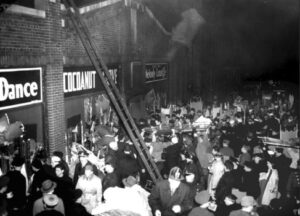
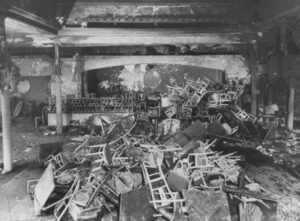 areas of the club. The problem…people were unable to escape due in part to locked exit doors. The only saving grace was that the local hospitals were especially well prepared to treat the casualties, because they had been rehearsing emergency drills in response to possible wartime attacks on the East Coast. Had that not been the case, the death toll would have likely included the 130 survivors too. If “good” can be said to come from tragedy, it would come in the form of the demonstrated value of the new blood banks and stimulated important advances in the treatment of burn victims. As always happens after a tragedy, many new laws were enacted for public establishments, including the banning of flammable decorations, a provision that emergency exits must be kept unlocked (from the inside), and that revolving doors cannot be the only exit.
areas of the club. The problem…people were unable to escape due in part to locked exit doors. The only saving grace was that the local hospitals were especially well prepared to treat the casualties, because they had been rehearsing emergency drills in response to possible wartime attacks on the East Coast. Had that not been the case, the death toll would have likely included the 130 survivors too. If “good” can be said to come from tragedy, it would come in the form of the demonstrated value of the new blood banks and stimulated important advances in the treatment of burn victims. As always happens after a tragedy, many new laws were enacted for public establishments, including the banning of flammable decorations, a provision that emergency exits must be kept unlocked (from the inside), and that revolving doors cannot be the only exit.
The investigation centered around Welansky’s blatant disregard for the safety of the very patrons who gave him his wealth by their continued patronage of his establishment. An official report revealed that “the Cocoanut Grove had been inspected by a captain in the Boston Fire Department (BFD) just ten days before the fire and declared safe. Further, it was found that the Grove had not obtained any licenses for operation for several years. There were no food handlers’ permits and no liquor licenses. Stanley Tomaszewski, the busboy who had allegedly started the fire, was underage and should not have been working there. Moreover, the recent remodeling of the Broadway Lounge had been done without building permits, using unlicensed contractors.” Tomaszewski testified at the inquiry and was exonerated, as he was not responsible for the flammable decorations or the life safety code violations. While declared innocent, Tomaszewski would pay for the “crime” anyway, in the form of being “ostracized for much of his life because of the fire.” Tomaszewski died in 1994. In the end, the blame was rightly assigned to Welansky, for violation of the existing safety standards, and upon 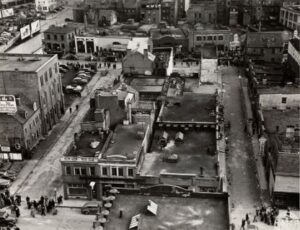
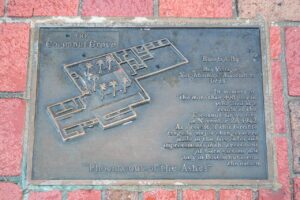 his conviction in 1943, Welansky was sentenced to 12–15 years in prison. Welansky served nearly four years before being quietly pardoned by Tobin, who had been elected governor of Massachusetts since the fire. In December 1946, diagnosed with cancer, Welansky was released from Norfolk Prison, telling reporters, “I wish I’d died with the others in the fire.” Nine weeks later on 27 Jan 1947 the cancer took his life. He was 49 years old.
his conviction in 1943, Welansky was sentenced to 12–15 years in prison. Welansky served nearly four years before being quietly pardoned by Tobin, who had been elected governor of Massachusetts since the fire. In December 1946, diagnosed with cancer, Welansky was released from Norfolk Prison, telling reporters, “I wish I’d died with the others in the fire.” Nine weeks later on 27 Jan 1947 the cancer took his life. He was 49 years old.


Leave a Reply